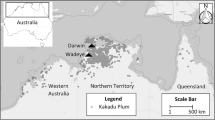Abstract
Baobab leaves form an important part of the local diet in Sahel countries and elsewhere in Africa. Existing leaf nutritional data and agroforestry performance information are based solely on Adansonia digitata L., the baobab of continental Africa. The introduction potential of Adansonia species from the center of diversity in Madagascar and from Australia remains untapped. To assess this potential, the mineral contents and B1 and B2 vitamin levels of dried baobab leaves were determined for five-year old trees of A. digitata, A. gibbosa (A. Cunn.) Guymer ex D. Baum, A. rubrostipa Jum. & H. Perrier (syn. A. fony Baill.), A. perrieri Capuron and A. za Baill. grown in an introduction trial in Mali. Nutritional data were evaluated against survival and vigor to identify promising germplasm. Leaf vitamin and crude protein contents were highest in the Madagascar species, especially A. rubrostipa (B1 88 mg 100 g−1, B2 187 mg 100 g−1, protein 20.7% dry weight). However, the local species far outperformed the introductions in survival, tree height, basal diameter and resistance to termites. We suggest grafting as a way of harnessing the vigor of well-adapted local baobab varieties to the superior nutritional profiles of A. rubrostipa and others. Cross-species grafting tests in Adansonia were successful, thus creating new agroforestry possibilities with different scion/rootstock combinations.




Similar content being viewed by others
References
Abushama FT, Abdel Nur HO (1978) Natural resistance of Sudanese timber against the sand termite Psammotermes hybostoma. Entomol Exp Appl 24(3):204–211
Baum D, Oginuma K (1994) A review of chromosome numbers in Bombacaceae with new counts for Adansonia. Taxon 43:11–20
Baum D (1995a) The comparative pollination and floral biology of baobabs (Adansonia—BOMBACACEAE). Ann Mo Bot Gard 82:322–348
Baum D (1995b) A systematic revision of Adansonia Bombacaceae. Ann Mo Bot Gard 82:440–470
Baum D (1998) Biogeography and floral evolution of baobabs (Adansonia, Bombacaceae) as inferred from multiple data sets. Syst Biol 47(2):181–207
Becker B (1983) The contribution of wild plants to human nutrition in the Ferlo (Northern Senegal). Agroforest Syst 1:257–267
Becker B (1986) Wild plants for human nutrition in the Sahelian Zone. J Arid Enviro 11:61–64
Boffa JM (1999) Agroforestry Parklands in sub-Saharan Africa. FAO Conservation Guide 34, FAO, Rome
Delisle H, Bakari S, Gevry G, Picard C, Ferland G (1997) Teneur en provitamine A de feuilles vertes traditionnelles du Niger. Cah Agric 6(8):553–560
Eurofins Danmark A/S. Accessed Nov. 1, (2006). www.eurofins.dk
Glew RH, VanderJagt DJ, Lockett C, Grivetti LE, Smith GC, Pastuszyn A, Millson M (1997) Amino acid, fatty acid, and mineral composition of 24 indigenous plants of Burkina Faso. J Food Compost Anal 10(3):205–217
Johnson PR, Green EJ, Crowhurst M, Robinson CJ (2006) Commercialization of boab tubers. Australian Government Rural Industries Research and Development Corporation RIRDC Publication No. 06/022
Kerharo J (1980) La pharmocopee Senegalaise traditionelle. Trop Sci 22(4):383–388
Nordeide MB, Hatloy A, Folling M, Lied E, Oshaug A (1996) Nutrient composition and nutritional importance of green leaves and wild food resources in an agricultural district, Koutiala, in Southern Mali. Int J Food Sci Nutr 47(6):455–468
Parkinson JA, Allen SE (1975) A wet oxidation procedure suitable for the determination of nitrogen and mineral nutrients in biological materials. Commun Soil Sci Plant Anal 6:1–11
Rasambainarivo JH, Ranaivoarivelo N Accessed Dec. 2, (2006). Madagascar. www.fao.org/AG/AGP/agpc/doc/counprof/Madagascar/madagascareng.htm
Sena LP, Vanderjagt DJ, Rivera C, Tsin ATC, Muhamadu I, Mahamadou O, Millson M, Pastuszyn A, Glew RH (1998) Analysis of nutritional components of eight famine foods of the Republic of Niger. Plant Foods Hum Nutr 52(1):17–30
Sidibe M, Williams JT (2002) Baobab. Adansonia digitata. International Centre for Underutilised Crops, Southampton, UK
Smith GC, Dueker SR, Clifford AJ, Grivetti LE (1996a) Carotenoid values of selected plant foods common to southern Burkina Faso, West Africa. Ecol Food Nutr 35(1):43–58
Smith GC, Clegg MS, Keen CL, Grivetti LE (1996b) Mineral values of selected plant foods common to southern Burkina Faso and to Niamey, Niger, West Africa. Int J Food Sci Nutr 47(1):41–53
StatSoft Inc. (2005) STATISTICA (data analysis software system), version 7.1. www.statsoft.com
StatistiXL (2006) StatistiXL (data analysis software system), version 1.6. www.statistixl.com
Von Maydell HJ (1984) Arbres et Arbustes du Sahel: leurs caracteristiques et leurs utilisations. Margaf, Weikersheim, Germany, 531 pp
Wickens GE (1983) The Baobab. Kew Bull 37(2):173–197
Yazzie D, VanderJagt DJ, Pastuszyn A, Okolo A Glew RH (1994) The amino acid and mineral content of baobab (Adasonia digitata L.) leaves. J Food Compost Anal 7(3):189–193
Acknowledgements
Grafting was done by Modibo Doumbia with guidance from Bréhima Koné and Mamadou Sidibé. Termite investigations and leaf sampling were carried out with the technical assistance of Mamoutou K. Coulibaly. Mme. Rokiatou Dianka Sissoko, Mme. Fatou Koné Coulibaly and Mamadou Konaté assisted in the lab. We also wish to thank Dr. Bamory Diarra of IER-LNA for his support.
Author information
Authors and Affiliations
Corresponding author
Rights and permissions
About this article
Cite this article
Maranz, S., Niang, A., Kalinganire, A. et al. Potential to harness superior nutritional qualities of exotic baobabs if local adaptation can be conferred through grafting. Agroforest Syst 72, 231–239 (2008). https://doi.org/10.1007/s10457-007-9093-2
Received:
Accepted:
Published:
Issue Date:
DOI: https://doi.org/10.1007/s10457-007-9093-2




